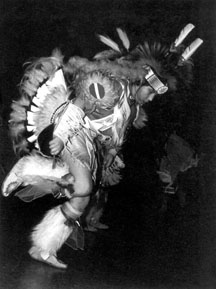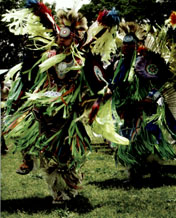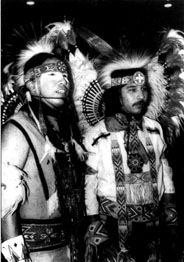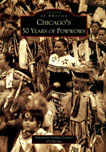|

 |
Chicago's Fifty Years of Powwows |
<Adapted from the book of the same name>
Men's Fancy Dance
This contemporary dance originated in Oklahoma. A difficult dance to perform, it requires strength, agility, and endurance. Some stories describe the men's fancy dance as a preparation for war. Dancers wear a modern dance outfit with its roots in the old grass
dance. It is a relatively new dance style. The dancers wear two
brilliantly colored feather bustles, and their outfits are much
flashier and more brightly colored than the men's
traditional outfits. Follow this link to see some Men's Fancy Dancers in action. >>>add video clip<<< >>>add historical picture/painting
near bottom of page<<<
The Fancy Dance, performed mostly by boys and young men, is based on the standard "double step" of the Men's Traditional and Grass Dances, but it takes off from there with highly elaborate dance footwork, greatly increased speed, acrobatic steps and motions and more varied body movements. The Fancy Dance is a freestyle kind of dance, in which dancers do whatever they can, as long as they keep up with the music. As in other dance styles, the dancers must follow the changing beat of the Drum and stop when the music stops, with both feet on the ground. This dance is a modern expression of Indian people combining the pace of today with the traditions of yesterday.
Fancy Dancing Regalia includes: Hair Roach: an item worn on the head of most dancers, usually made of deer tail lair and porcupine hair guard. Bells: (sheep or sleigh) help to maintain the rhythm of the dance. Bustles: these are the arrangement of feathers worn on the neck and back of fancy dancers. The primary part of the bustle is the feather. These were at one time, eagle feathers. Today, many are made of white or dark turkey feathers decorated with small colorful feathers called hackles. In addition to the bustles of the Fancy Dancers, another noticeable part is the elaborate beadwork. Many dancers strive to have all matching beadwork.
Forward to the next page of this essay Back to the previous page of this essay Back to the menu of powwow dances Back to the menu page for this essay Back to Online Essays
|
| |
Department
of Anthropology |
copyright ©
2002 University of Illinois, All rights reserved. |





